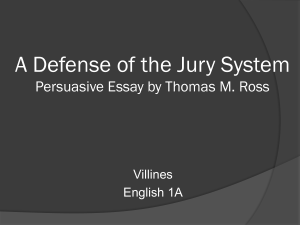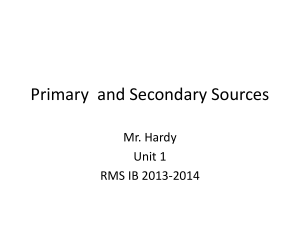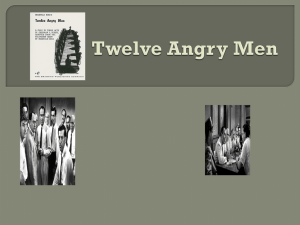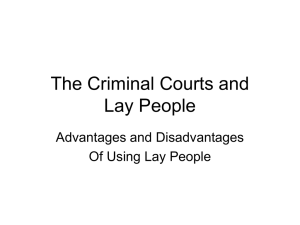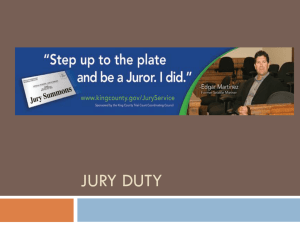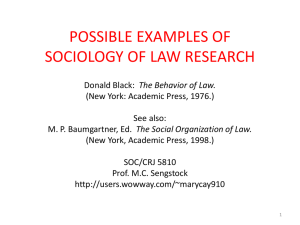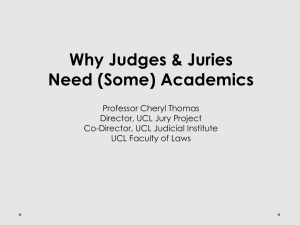PP CH. 12
advertisement
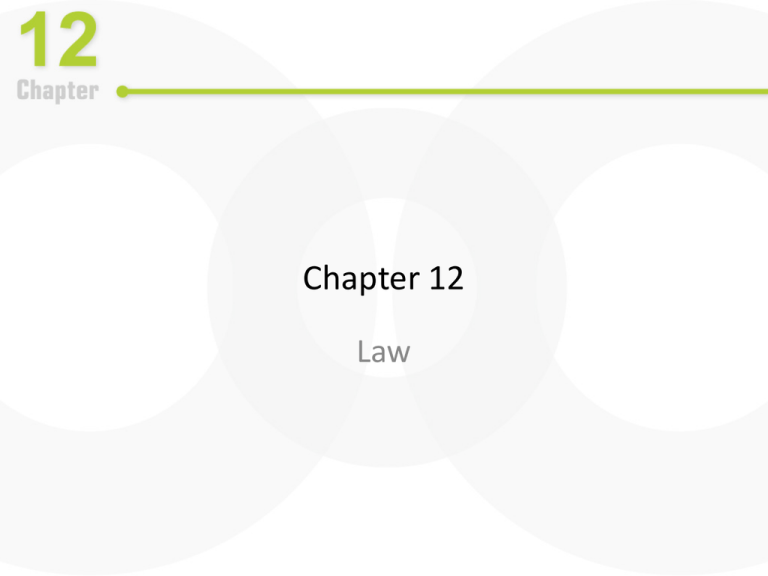
Chapter 12 Law The Social Psychology of Evidence Overview of the American Criminal Justice System Eyewitness Testimony • How accurate are eyewitness accounts? • Three conclusions about eyewitness testimony: – Eyewitnesses are imperfect. – Certain personal and situational factors systematically influence eyewitness’ performance. – Judges, juries, and lawyers are not well informed about these factors. Eyewitness Testimony: Acquisition • Refers to the witness’s perceptions at the time of the event in question. • Factors influencing acquisition: – One’s emotional state – Weapon-focus effect – Cross-race identification bias Eyewitness Testimony: Storage • Refers to getting the information into memory to avoid forgetting. • Memory for faces and events tends to decline over time. • But, not all memories fade over time. – However, the “purity” of the memory can be influenced by postevent information. Eyewitness Testimony: Storage (cont.) • Misinformation Effect: The tendency for false postevent information to become integrated into people’s memory of an event. • If adults can be misled by postevent information, what about children? – Repetition, misinformation, and leading questions can bias a child’s report, particularly for preschoolers. Biasing Eyewitness Reports With Loaded Questions Eyewitness Testimony: Retrieval • Refers to pulling the information out of storage when needed. • Factors affecting identification performance: – Lineup construction – Lineup instructions to the witness – Format of the lineup – Familiarity-induced biases Courtroom Testimony of Eyewitnesses • Eyewitness testimony in court is persuasive and not easy to evaluate. • Why do jurors often overestimate the accuracy of eyewitnesses? – Lack knowledge about human memory. – Base judgments largely on witness’s confidence. Morphing Composite Faces to Catch a Thief Effects of Lineup and Instructions on False Identifications The Biasing Effects of PostIdentification Feedback Improving Eyewitness Justice • Educate judges and juries about the science so they can better evaluate eyewitnesses who testify in court. • Make eyewitness identification evidence itself more accurate. What Eyewitness Experts Say in Court What Eyewitness Experts Say in Court The Psychology of Lie-Detection • Polygraph: A mechanical instrument that records physiological arousal from multiple channels. • Do the lie-detector tests really work? – Truthful people often fail the test. – The test can be faked by artificially inflating arousal responses to “innocent” questions. Approaches to Police Interrogations • Pressure the suspect into submission by expressing certainty of his or her guilt. • Befriend the suspect. The Nine Steps of Interrogation False Confessions • May confess merely to escape a bad situation. • Internalization can lead innocent suspects to believe they might be guilty of the crime. • Two factors can increase the risk of false confessions: – Lack of a clear memory of the event in question – Presentation of false evidence Factors That Produce False Confessions Do Guilty Expectations Produce False Confessions? Confessions and the Jury: An Attributional Dilemma • Juries are powerfully influenced by evidence of a confession, even if the confession was coerced. – Fundamental attribution error revisited. • A jury’s reaction can be influenced by how confession evidence is presented. Jury Decision Making Jury Selection • Voir dire is the pretrial examination of prospective jurors by the judge or opposing lawyers to uncover signs of bias. • A peremptory challenge is a means by which lawyers can exclude a limited number of prospective jurors without the judge’s approval. Trial Lawyers as Intuitive Psychologists • As far as trial practice is concerned, how-to books claim that the astute lawyer can predict a juror’s verdict by his or her gender, race, age, ethnic background, and other simple demographics. Scientific Jury Selection • A method of selecting juries through surveys that yield correlations between demographics and trial-relevant attitudes. • Does scientific jury selection work? • Is scientific jury selection ethical? Juries in Black and White: Does Race Matter? • To what extent does a juror’s race color his or her decision making? Research suggests that there is no simple answer to this question. Effects of Racial Diversity on the Jury Death Qualification • A jury selection procedure used in capital cases that permits judges to exclude prospective jurors who say they would not vote for the death penalty. • Are death-qualified juries prone to convict? The Courtroom Trial Nonevidentiary Influences: Pretrial Publicity • Does exposure to pretrial news stories corrupt prospective jurors? • Why is pretrial publicity potentially dangerous? – Often divulges information that is not later allowed into the trial record – Issue of timing Contaminating Effects of Pretrial Publicity Nonevidentiary Influences: Inadmissible Testimony • Why do people not always follow a judge’s order to disregard inadmissible evidence? – Added instruction draws attention to the information in controversy. – Judge’s instruction to disregard may arouse reactance. – Jurors want to reach the right decision, so it is hard to ignore information that seems relevant to the case. Nonevidentiary Influences: The Judge’s Instructions • To make verdicts adhere to the law, juries are supposed to comply with the judge’s instructions. • Do jurors understand their instructions? • What about the timing of the instructions? • What if the jury disagrees with the law? – Jury nullification Jury Deliberation Leadership in the Jury Room • A person is more likely to be chosen as foreperson if the person: – Is of higher occupational status or has prior jury experience – Is a male – Is the first person who speaks – Is sitting at the head of a rectangular table • Forepersons act more as the jury’s moderator rather than its leader. The Dynamics of Deliberation • In criminal trials, deliberation tends to produce a leniency bias favoring the defendant. – leniency bias is the tendency for jury deliberation to produce a tilt toward acquittal. • How do juries resolve disagreements? – A combination of informational and normative influence Jury Deliberations: The Process The Road to Agreement: From Individual Votes to a Group Verdict Jury Size • How does jury size affect the decision-making process? – Possible lack of allies in smaller juries may make it harder to resist normative pressures. – Smaller juries are less likely to represent minority segments of the population. – Smaller juries are more likely to reach unanimous decisions after shorter deliberation periods. Less-Than-Unanimous Verdicts • Weakens jurors who are in the voting minority. • Breeds closed-mindedness. • Short-circuits the discussion. • Leaves many jurors uncertain about the decision. Posttrial To Prison and Beyond The Sentencing Process • People disagree on the goals served by imprisonment. – Incapacitate offenders and deter them from committing future crimes? – Exact retribution for misdeeds? • Common public complaint is sentencing disparity. – Sentencing disparity is the inconsistency of sentences for the same offense from one judge to another. The Prison Experience • Does the prison situation lead guards and prisoners to behave as they do? • Zimbardo et al.’s (1973) Stanford Prison Study. • How does this study inform the power of the situation? Perceptions of Justice Justice as a Matter of Procedure • Satisfaction with dispute resolution depends on both the outcome and the procedure used to achieve those outcomes. • Important aspects of procedure: – Decision control – Process control Which Legal System Do People Prefer? • Adversarial Model: The prosecution and defense present opposing sides of the story. • Inquisitorial Model: A neutral investigator gathers evidence from both sides and presents the findings in court. • Adversarial proceedings seen as more fair and just because the method offers participants a voice in the proceedings. Culture, Law, and Justice • Much of research from this chapter can be universally applied – Yet there are important cross-cultural differences • Different nations have different laws • Different cultures have different customs • Likewise, punishments for crimes also vary Closing Statement Closing Statement • Through an understanding of social psychology we can now identify the problems in the legal system and even find some solutions.


